The influencer marketing industry has grown from $1.7 billion in 2016 to $13.8 billion in 2021.

Image via Statista
Influencer marketing has established its spot as a major marketing strategy that more and more brands are willing to leverage every year.
But if you are like most business owners, you’ve probably faced the micro-influencers vs. celebrities dilemma.
After all, celebrities are the traditional go-to for marketing since they have fame and often millions of followers on social media while micro-influencers only have their social media following of less than 100K people.
But that does not make celebrities better, and here’s why.
Table of Contents
Micro-Influencers vs. Celebrities: A Comparison
Before our micro-influencers vs. celebrities comparison, let’s look at an overview of each.
Who are Micro-Influencers?
Micro-influencers are individuals with a social media presence that’s between 10,000 and 100,000 followers or subscribers.
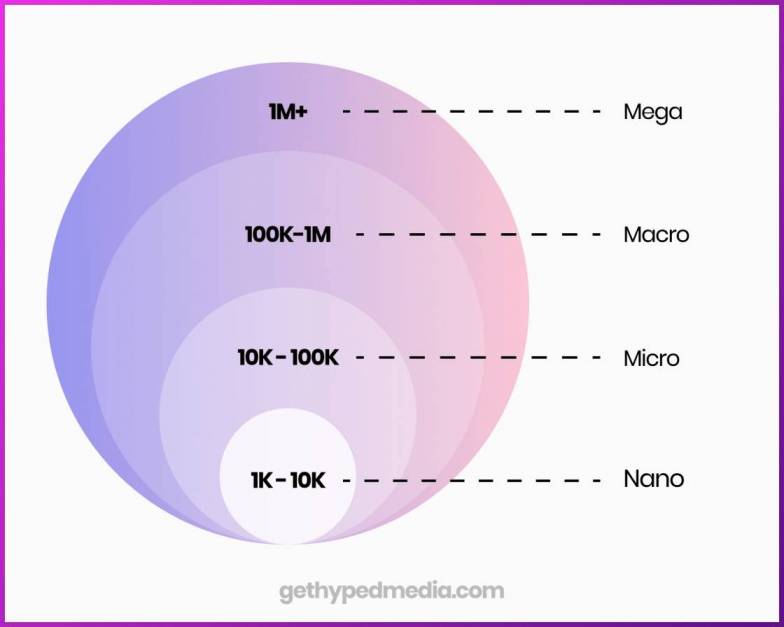
Who are Celebrities?
Celebrities are individuals who live in the public eye. They aren’t just famous on social media, but they have offline fame as well in traditional media.
Celebrities on social media typically have a follower count of over 1 million.
Let’s now compare each on social media specifically.
Micro-Influencers vs. Celebrities: Content Creation
Micro-influencers are typically knowledgeable in their niche and are expert content creators. This means that their skills can easily help you create content in an influencer marketing campaign.
Micro-influencers spend tons of time creating content on social media so they are more likely to create sponsored content that’s relevant to their audience.
You want to give micro-influencers sufficient creative freedom as they know what their audience likes best.
Look at this Instagram post from Amanda Holtzer, for instance. She’s a food and nutrition influencer.

Image via Instagram
She’s made chocolate-covered crackers and promoted snacks from Tosh in the process.
She uses the same tone for the sponsored post that she uses in her unsponsored posts like the one below.
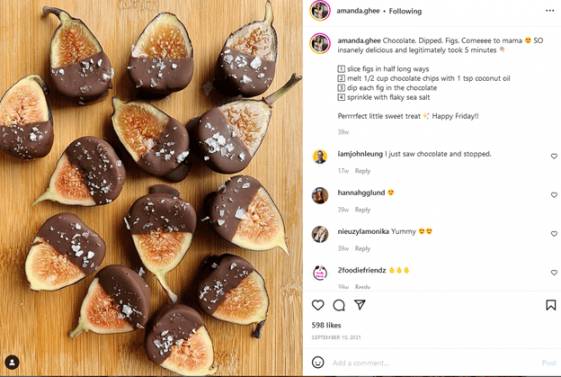
Image via Instagram
Denying an influencer creative freedom could create inconsistency in the tone of the post, which the audience might notice. It could affect the effectiveness of the post.
As long as you’ve partnered with the right micro-influencer, you must trust their content creation capabilities.
For celebrity influencers, they’re going to ask your business or influencer marketing agency to come up with content concepts and detailed messaging for the sponsored post.
The celebrity’s role is to give the storyline or idea a face and use their fame and influence to achieve the desired effect on the audience.
See this post from Cristiano Ronaldo promoting CLEAR, a dandruff solution.
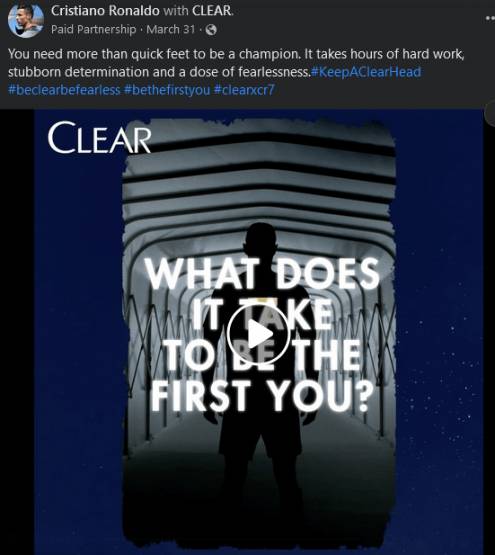
Image via Facebook
The post is different from his usual posts that involve football.
When a celebrity influencer posts scripted content that’s off-topic from their usual content, it can result in the celebrity’s post coming off as inauthentic to their audience.
Micro-Influencers vs. Celebrities: Audience
When it comes to the audience in the micro-influencers vs. celebrities debate, each type of influencer brings a unique benefit to the table.
To start, micro-influencers target a very specific niche audience that celebrity influencers simply cannot due to their broad, massive following.
Because the micro-influencer audience is so niche-specific, working with a micro-influencer greatly increases the chances that your campaign will bring in quality leads and customers from their small audience.
The audience of celebrity influencers is much broader. They have a massive reach across many niches, which can translate into tons of brand awareness and numerous leads, all from one individual.
With a celebrity influencer, you can be sure your campaign will reach millions of people from diverse groups.
That said, while the number of leads from a celebrity partnership could be massive, they will not all be targeted due to the broader nature of the celebrity’s audience.
Micro-Influencers vs. Celebrities: Authenticity
About 98% of customers read online reviews of businesses and this will, of course, impact their impression of your business.
Additionally, seeing a ‘peer’ recommending a product is likely to influence a customer more than an ad from the brand as it’s coming from a customer.
So, here’s the thing — people see micro-influencers as peers who go through the same challenges they do. And they definitely don’t view celebrities this way.
Micro-influencer content is viewed as authentic and relatable.
And micro-influencers aren’t unreachable either, like celebrities. It’s this close connection with the micro-influencer audience that you can harness through influencer campaigns.
Think of Joanna Goddard of Cup of Jo, for instance. She’s a mom who shares relatable stories of her journey in motherhood.
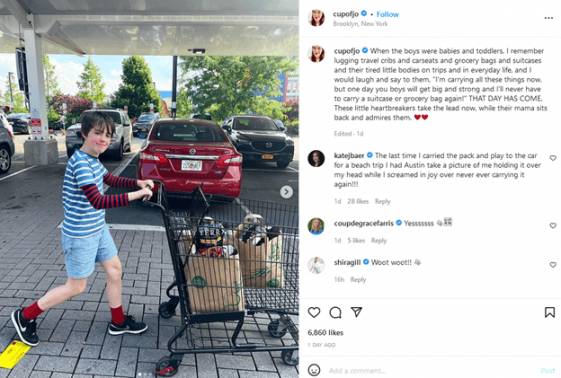
Image via Instagram
Such authenticity increases the conversions you’ll get from partnerships with micro-influencers. It also makes micro-influencers a great fit to humanize your brand and build its trustworthiness.
With celebrities, there is always a risk that the celebrity endorsement will come off as inauthentic. If you choose to work with a celeb, carefully pick one who actually enjoys your brand or products.
And this is where another problem comes in.
There aren’t nearly as many celebrity influencers as micro-influencers. You don’t get the luxury of being picky.
Plus, celebrity influencers are notoriously difficult to contact. You can’t just email or DM them like a micro-influencer and expect a response. You have to find out who their manager is, contact them, and most times you still won’t get a response because most celebrities are insanely busy with schedules booked months in advance.
That said, picking the right celebrity can absolutely drive massive conversions if you’re able to get in touch with them and agree on a partnership. Tons of people still look up to celebs and identify with the causes they’re promoting as well. Individuals are more willing to try out products that a celebrity endorses.
Micro-influencers vs. Celebrities: Engagement Rate
Micro-influencers have highly-engaged audiences due to the close connection that they’ve developed with them. This can make their sponsored posts very effective for the level of investment.
Engagement rates, however, tend to decrease as the follower count increases on social media. It’s easier to have an intimate connection with a small following.
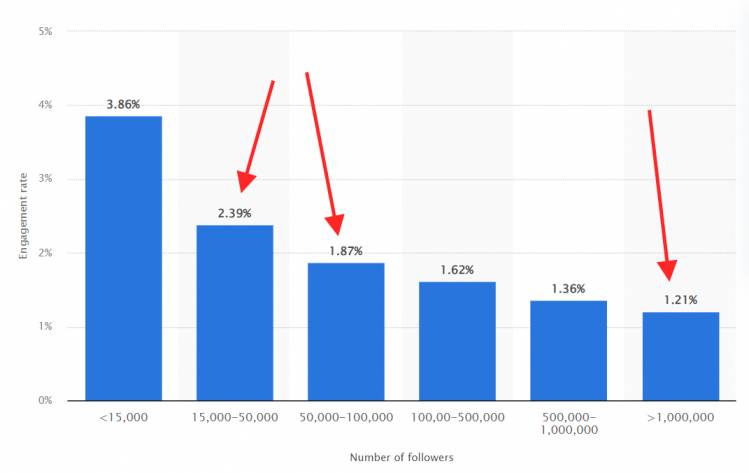
Image via Statista
Additionally, the followers of micro-influencers are more likely to be passionate about their niche. It prompts them to like, share, and comment on the influencer’s posts more often.
And given their manageable numbers, the micro-influencer can respond to most or all of their comments and messages, prompting even more engagement.
The followers of celebrity influencers have varying interests and passions. This makes it hard for the celebrity influencer to post content that engages the majority of their audience.
Plus, their celebrity status makes it difficult for the influencers to connect with their followers. At best they can only interact with a handful of them.
Celeb’s lack of responses can deter their audience from commenting on their posts. They know the chances of getting any response to a comment are slim to none so why bother?
This makes micro-influencers the best bet if you want to drive up your engagement rates.
Micro-Influencers vs. Celebrities: Pricing
When it comes to the battle of cost among micro-influencers vs. celebrities, micro-influencers charge a fraction of what celebrities charge.
If you’re launching an Instagram influencer marketing campaign, a post from a micro-influencer can cost anywhere from a free product up to $10,000 or more, depending on their niche.
But a celebrity influencer will never post for free products, and they charge at least $20,000 a post, usually much more than that, with celebrities like Cristiano Ronaldo charging as high as $1 million per sponsored post.
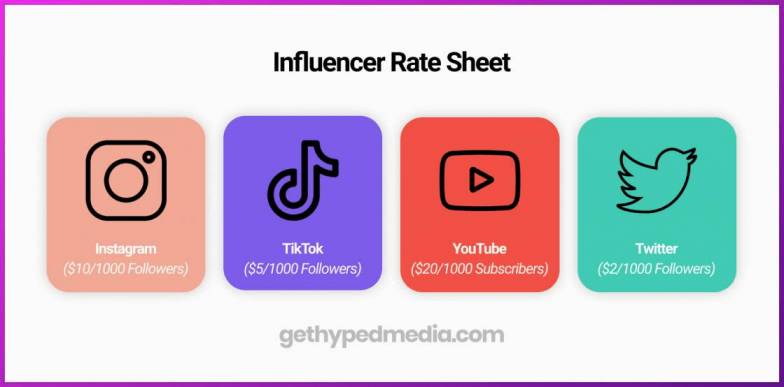
In a nutshell, you need deep pockets to partner with celebrities. But that’s not the case with micro-influencers.
If you’re willing to spend the time to reach out to a ton of micro-influencers, you could get a sponsored post in exchange for a free product too, but that’s becoming increasingly harder to do as the demand for influencers continues to increase.
What does this all mean?
- Startups and SMEs can benefit from influencer marketing by partnering with micro-influencers.
- Brands can work with several micro-influencers in different niches to reach a variety of audiences instead of partnering with a single celebrity.
- The influencer marketing ROI can be impressive for both cases.
Micro-influencers vs. Celebrities: Which One Should You Choose for Your Next Campaign?
We don’t have a clear winner in this micro-influencers vs. celebrities comparison. And that’s because the choice depends on the goals and budget of your specific brand.
Micro-influencers have:
- Higher engagement rates
- More loyalty from their followers
- A targeted audience
- High authenticity
- Affordable pricing
Celebrities have:
- A much larger audience
- Fame, influence, and glamor
- Familiarity with your audience
- A high price point
A great strategy for an influencer marketing campaign that many brands choose is to partner with one celebrity influencer as the face of their campaign.
They then add a large group of micro-influencers as well to bring support to the celeb’s content and amplify it. Leveraging a mix of celebrities and micro-influencers for your campaign in this way can be very effective.
FAQs
1. Are influencers micro-celebrities?
Yes. Influencers are micro-celebrities who are famous within specific niche markets on social media platforms.
2. What is the difference between a celebrity influencer and a micro-influencer?
Celebrity influencers differ from micro-influencers in:
- Follower count: Celebrities have a significantly high follower count compared to micro-influencers.
- Cost: Celebrities charge significantly more than micro-influencers.
- Engagement: Celebrities have typically lower engagement rates than micro-influencers.
- Audience: Celebrities have a more generic audience.
3. What is the difference between a celebrity and an influencer?
Traditional celebrities gain fame and fans through various media channels, such as television. They get fame from areas like the entertainment industry and sports.
Influencers gain fame and followers online through content creation on social media channels. They are experts in specific niches.
4. Why are micro-influencers often more effective than celebrity influencers?
Micro-influencers are often more effective than celebrities for small brands and startups owing to their powerful connections with their audience and their relatively cheap partnership cost.
5. Should you use celebrity influencers in your advertising campaign?
Celebrities have a massive audience and that means that you’ll be able to boost your reach with ease. Additionally, their followers look up to them for recommendations and this can help in driving your lead generation and conversions too. That makes celebrities a great choice for your campaigns as long as you have the budget to afford them.
Wrapping Up
Choosing the right influencer for your campaign is critical to its success.
If you’re planning a large-scale campaign for brand awareness, going with a celebrity is the best bet. On the other hand, to drive greater engagement, you should consider partnering with a bunch of micro-influencers.
At Get Hyped, we’ll find and partner with the perfect influencers for your brand, whether that’s celebs, micro-influencers, or a combination of both. So get in touch with us for a consultation when you’re ready to launch your next influencer campaign.



